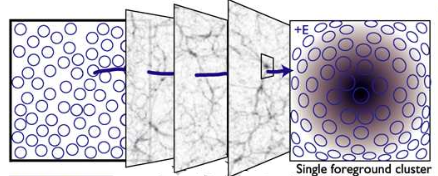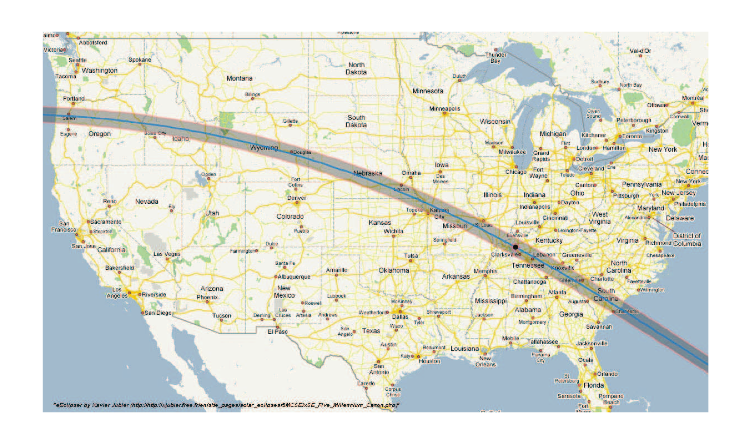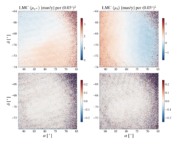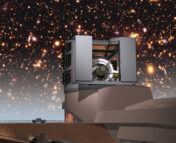Title: Observing Dark Worlds: A crowdsourcing experiment for dark matter mapping.
Authors: D. Harvey, T. D. Kitching, J. Noah-Vanhoucke, B.Hamner, T. Salimans.
First Author’s institution: SUPA, University of Edinburgh, Royal Observatory, UK.
Galaxies and clusters live within overdensities of dark matter, or halos. The abundance of dark matter halos tells us something about how the Universe has evolved and the laws that govern its evolution. But how can we locate these dark matter halos? One option is to count galaxies and identify overdensities of galaxies with dark matter halos, since baryons and dark matter clump together by gravity. Is there a more direct way of probing the dark matter? Yes, gravitational lensing distorts the path of photons such that a galaxy behind a dark matter halo looks more elliptical in the tangential direction. (See the figure below.) By measuring the average ellipticity of galaxies surrounding a point, it can be determined whether that point is the center of a dark matter halo. ‘Observing dark worlds‘ is a citizen science project that aims to improve on the algorithms to find dark matter halos in simulated maps of galaxy shapes that have been subject to gravitational lensing. In this paper, the authors present the results of the challenge.

The effect of a cluster of galaxies on the shapes of galaxies in the background due to gravitational lensing. To make the effect more evident, the background sources are assumed to be round. When we look at them through the web of dark matter, galaxy ellipticities are distorted tangentially surrounding the center of the dark matter halo that appears within the small black box. From Kitching et al. (2010).
Get involved
Citizen science projects have been very successful in involving the public in everyday research. Galaxy Zoo had tremendous participation in which volunteers classified galaxies and inspected images of astronomical objects,and the findings led to many publications. The Stardust@Home project asked users to identify dust particles collected in the encounter of the Stardust spacecraft with comet Wild 2. SETI@Home has engaged several million users around the world, who donate part of their personal computer time to process the deluge of SETI data trying to find narrow-bandwidth radio signals from space. ‘Observing dark worlds‘ (in partnership with Kaggle) is different in that it requires the user to write an algorithm to solve a problem. It is more similar in spirit to the GREAT challenges, a competition to find the best algorithm to measure the shapes of galaxies in simulated astronomical images.
The competition
In the competition, the users were given two months to ‘train’ their algorithms in a set of catalogues of galaxy positions and ellipticities where the true position of the dark matter halo and subhalos were known. Then, there was a ‘public test set’, a catalogue of galaxies and shapes for which they did not know where the dark matter halos were. The task was to find them. They received a score that would tell them how well they had done and were then allowed to iterate and improve on their algorithm. Finally, there was a ‘private test set’. Once again, users ran their algorithms on the set and submitted the results. On this final set, the score was not provided and the results were used to rank the performance of the algorithms.

The performance of the three winning algorithms in terms of the offset between the reported center of the dark matter halos and their true positions as a function of the mass. More massive halos are located to greater accuracy. Compare to LENSTOOL, which can locate a 1013 solar mass halo (more or less the halo of a group of galaxies) with a typical uncertainty of 10”. From Harvey et al. (2013).
The results
357 users presented algorithms for this search.
The three winning algorithms are presented in detail in the paper. Their performance was evaluated by looking at the typical distance between the true halo center and the reported position, and whether there was a bias in a particular direction in the offset. The winning entries displayed a >30% improvement over LENSTOOL, one of the algorithms most widely used by the astronomical community.
In a nutshell, the top two algorithms use the information in the training set to construct models for the dark matter halos. Then they compute the probability of a dark matter halo being at a given position using the ellipticities and positions of the galaxies in the private simulated maps. The third algorithm constructed a model for the ellipticity of galaxies based on the existence of three classes of halos -large, medium and small- and looked for halos maximizing a function that compares the data to the model.
The way forward
The authors have found the competition very useful for developing algorithms that would solve the required problem. They suggest that, in the future, similar competitions can lead to fast improvements in data analysis algorithms in astronomy. A similar competition going on right now is the GREAT3 challenge. Would you get involved?




